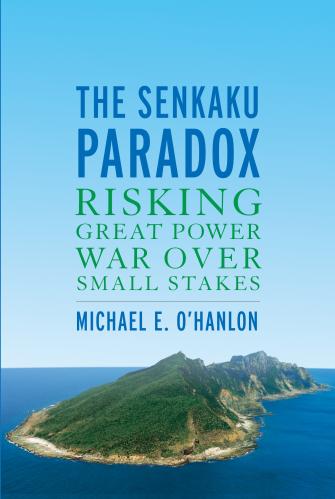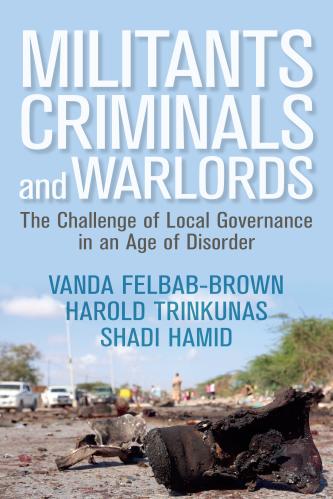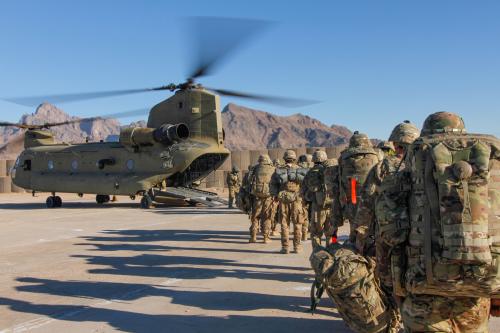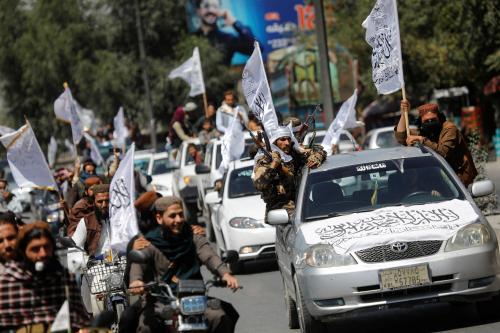Could it really be that the war in Afghanistan, now nearly two decades old for Americans and more than four decades old for Afghans themselves, may really be coming to a close?
Reportedly, the first part of a deal that could eventually bring peace to Afghanistan, and troops home to America, may be close. Negotiated by Afghan-born U.S. diplomat Zalmay Khalilzad, as well as the Taliban, it is to begin with a week-long reduction in violence nationwide — not a ceasefire proper, but a temporary cessation of large-scale attacks (which we believe must be monitored and confirmed by multiple parties, including the United Nations and NATO military command). We are now several days into that week, and so far the basic concept appears to be holding.
The phase one deal would also include an irreversible (and already ongoing) U.S. drawdown, from about 14,000 American troops to 8,600. For their part, beyond the ceasefire, the Taliban would have to sever links to al-Qaida and affiliates — even though one such affiliate, the Haqqani network, is an instrumental part of their current leadership. So these steps would require some real decisions and changes, even though they would not end the war or bring all American troops home.
Thus, a second phase of a peace accord would be essential. This time, America’s role would be secondary to that of Afghans on both sides of the conflict. The general goals of phase two would reportedly include a complete, or at least nearly complete, U.S.-NATO troop departure, as well as a real Afghan power-sharing agreement between the Taliban and a broad team including the current government as well as other supporters of what might be called a republican, constitutional Afghanistan. This phase would also feature, naturally and necessarily, an end to the violence.
At present, we are a long ways from any such agreement — even though President Trump would love to be able to announce a U.S. withdrawal by November. The Taliban does not even recognize the legitimacy, or existence, of the current Afghan government led by President Ashraf Ghani and the man he has apparently now defeated in two straight (highly imperfect) presidential elections, Abdullah Abdullah. For its part, that Afghan government — which controls all the nation’s cities, rules over 60% of the nation’s population, and enjoys constitutional legitimacy and international recognition — will not defer to the Taliban either. Therefore, no concrete concepts for sharing power have yet been discussed — and it is not clear any have even been seriously developed within each camp.
In effect, the Taliban want a reset of the current system — a new constitution or no constitution, an emirate where their leader effectively becomes emir (as in Iran), and more stringent Islamic laws under a type of “sharia” system. The government, on the other hand, wishes to see the Taliban accept the status quo and get integrated into the current system. Both views are unrealistic. The government’s proposed negotiating team currently excludes the legitimate opposition parties as well as most elements of civil society and the media; the Taliban’s approval rating barely registers above 10%. Both have to make compromises.
Making things even more complicated, when describing the second phase of a peace accord notionally, officials sometimes suggest that the U.S.-NATO departure would happen as soon as intra-Afghan talks get underway, not when they reach agreement and implementation. This would badly skew incentives for the Taliban. Even if its leaders decided to make a show of negotiating, they would be unlikely to do so in good faith, expecting the United States to pull out at the first hint of any real discussion whether a deal takes shape or not.
So rather than react favorably to the first promise of a peace accord, the United States needs some ways to distinguish good deals from bad ones. Americans’ understandable frustration with their own country’s longest war, and a desire of most presidential candidates to promise a rapid end to it, should not blind us to the possibility of a negotiated catastrophe. What is more, the U.S. troop presence in Afghanistan has been reduced by more than 85% since its peak a decade ago. The nation can sustain some fraction of it a bit longer if necessary, given the importance of preventing this part of the world from again becoming a sanctuary for international terrorists like it was 20 years ago, and of losing the progress in development and human rights that has been achieved, however imperfectly, in Afghanistan since 2001.
The bad options
One bad deal would be a complete U.S.-NATO troop departure at the first sign of serious negotiations between the Ghani government and the Taliban. That would almost certainly fail the way the Paris Peace Accords did over Vietnam. The Taliban would likely interpret any such deal as a fig leaf for Washington wanting to end its role in the war at all costs. (President Trump might be the perpetrator of such a mistake, but if given the chance, so might many of the Democrats running for president.) Because the Taliban believes that it is winning the war, that Ghani’s government is illegitimate and weak, and that, according to a Taliban expression, “the West has the watches but we have the time,” such an approach would seem to vindicate what they have expected for 20 years.
Most likely, in the ensuing negotiations after NATO troops were gone, they would drive a very hard line with the Afghan government. They might well insist on being recognized themselves as the new government of the Islamic Republic of Afghanistan, with not only Ghani but the constitution and parliament jettisoned along the way, as well as existing Afghan army and police (perhaps with some face-saving inducements in the form of amnesty and financial compensation). If the Taliban took this approach, such talks would almost surely break down. All-out civil war would then probably ensue. Alternatively, the Taliban might try to look more reasonable and agree to a deal they had little intention of honoring; things might then unravel quickly once the foreign troops were out.
A slightly better, but still bad, deal would hinge everything on U.S., NATO, Japanese, and other international economic leverage. It too could involve a rapid departure of foreign troops, but we could tell the Taliban that any future foreign aid would depend on it finding a compromise with Ghani’s government and holding to it. This might be part of a package that allowed the United States a small long-term counterterrorism presence in Afghanistan as well (to watch the Haqqani network in nearby Pakistan, and other possible al-Qaida presence in the region). Because the Afghan government and its security forces are so dependent on foreign aid — close to $10 billion per year from all sources combined — there is a chance this would give the United States and other outside powers real leverage over the Taliban. The promise of funding could, in theory, get them to compromise even without NATO military leverage.
However, in the end this tempting concept seems unpromising. As we see from North Korea to Syria to Libya and beyond, most extremist political movements and governments prioritize power over foreign aid. The Taliban have been pursuing power without Western aid for 25 years, and withstood severe sanctions when in power in the 1990s; it’s questionable just how much they’d really compromise on sharing power in response to economic incentives.
Components of a better deal
Still, there might just be ways to cajole and coerce the Taliban to reasonable power-sharing, if the United States is patient and resolute in the process, and avoids sending signals of abandoning the Ghani government. Good deals would have all of the following components and characteristics:
– The Taliban would stop trying to control who on the government side it negotiated with, and accept the legitimacy of the other party, even as President Ghani also promised an inclusive negotiating team on the government side that transcended his own finite presidential term;
– Most foreign forces would not leave until a peace deal was reached and then implemented over a period of at least a couple years, allowing the foreign forces to remain in a strategic overwatch role (it is very doubtful foreign forces would return to enforce a deal once a withdrawal was complete, so timing would be crucial);
– NATO forces’ departure might be succeeded by an international U.N. peacekeeping force that, while not mandated to impose peace through force of arms, could help monitor an accord as a way of determining if the future government should continue to receive international aid as promised. Other foreign specialists working in areas of development would also have to be allowed sustained access to the country;
– Not only human and gender and religious rights, but elections of some sort — together with protections for free speech — must be part of any future Afghan political system, with U.N. officials and development experts monitoring implementation. The Taliban should not be allowed simply to rule the country by force or to muzzle core elements of the new Afghan democracy — or to push the several million Afghan girls now getting at least rudiments of an education out of their schools and back into their homes.
– Rather than dismantle either the Taliban’s fighting forces or the current Afghan army and police, which would not be likely in the first case and not desirable in the second, any peace accord should allow them all to remain intact (and be paid). Over time, they could gradually be brought under regional coordination commands that de-conflicted their respective roles, rather than integrating them quickly or requiring one side or the other to disband.
Absent insistence on such fundamentals, however, a bad deal is the most likely outcome of Afghan peace talks.
Beyond these central principles, the international community can and should be very flexible over matters like the sharing of cabinet positions, revisions to the Afghan constitution that would decentralize power to the regions, and other matters where the Afghan negotiators might find ways to compromise. Washington could also offer greater aid and trade privileges to Pakistan — but conditionally, based on its willingness to show real support for any such deal, and with the threat to cut off existing aid if it directly or indirectly opposes the deal.
Absent insistence on such fundamentals, however, a bad deal is the most likely outcome of Afghan peace talks. America might find a way out of this war, at least temporarily — but Afghanistan most likely will not, and the region could again descend into the type of anarchy that allowed al-Qaida to establish a foothold there more than 20 years ago. That is not an experiment that anyone should want to run. For all the frustrations of the Afghanistan war, for Afghans as well as Americans, the core goals of protecting the American homeland and providing a better life to the Afghan people have been at least partly achieved. They should not be squandered.









Commentary
Good deals — and bad ones — with the Taliban
February 25, 2020